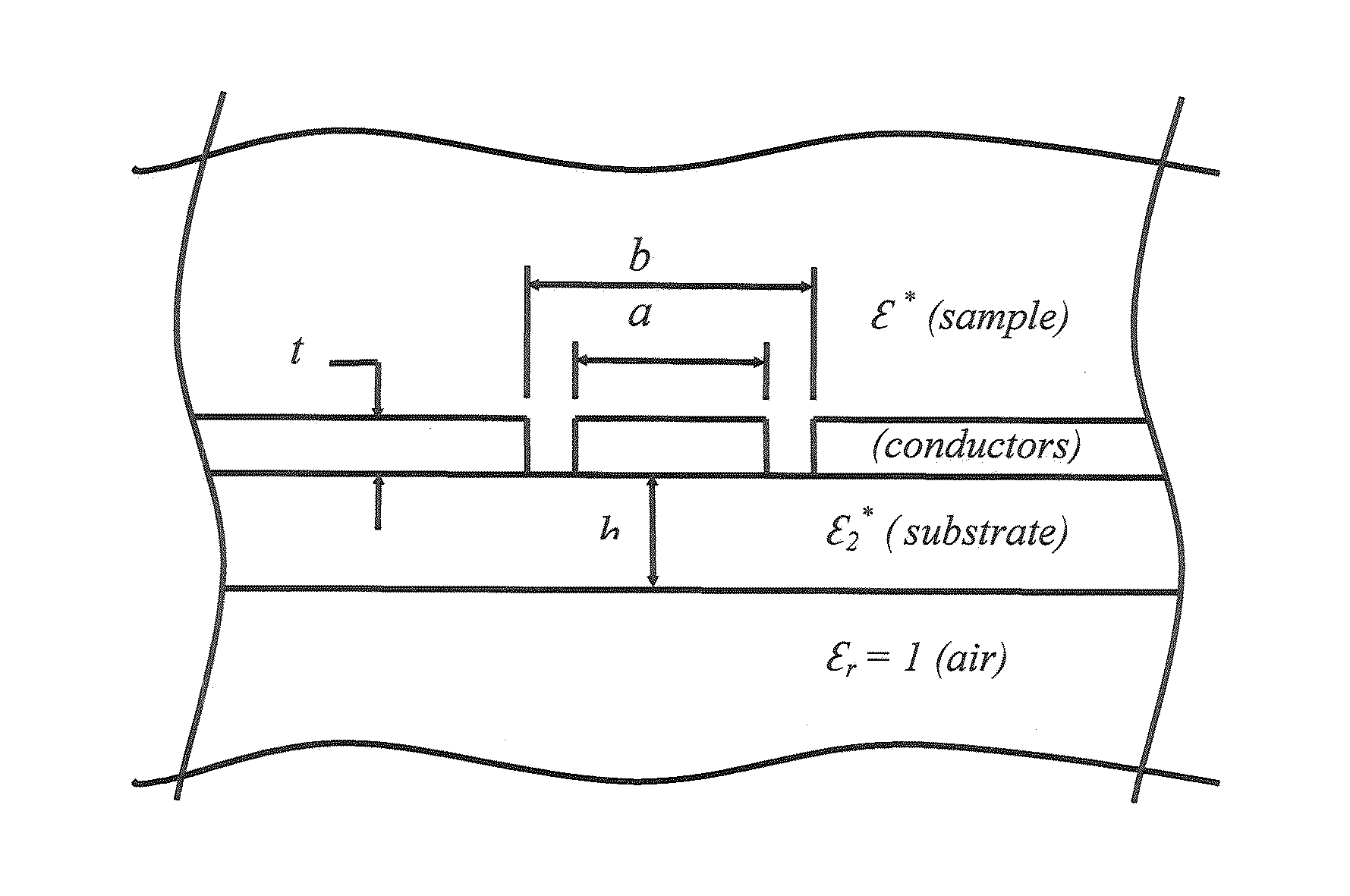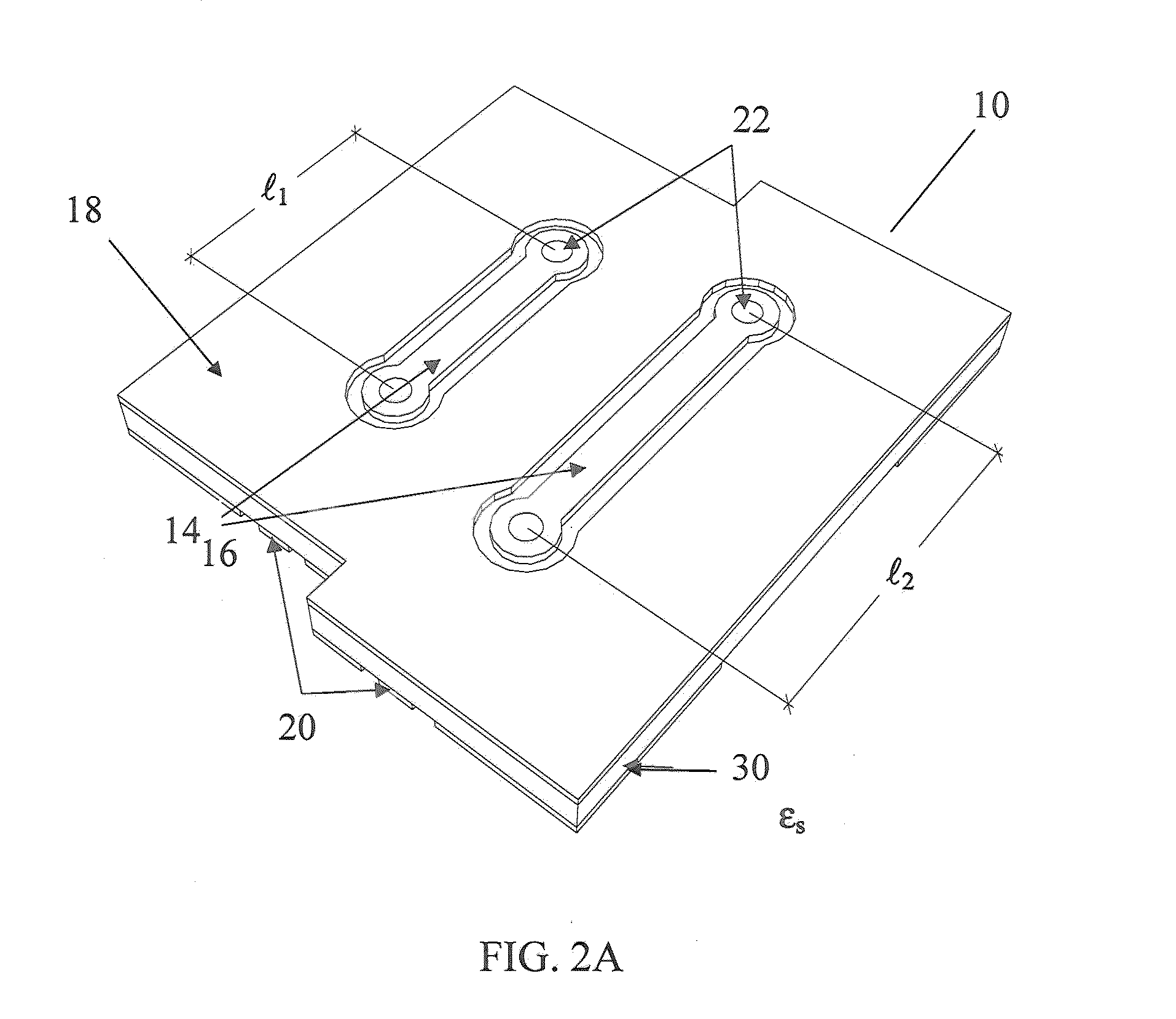Planar transmission-line permittivity sensor and calibration method for the characterization of liquids, powders and semisolid materials
a technology of permittivity sensor and transmission line, which is applied in the direction of dielectric property measurement, resistance/reactance/impedence, instruments, etc., can solve the problems of inconvenient use of open-ended coaxial-line probes to characterize the dielectric anisotropy of materials, large sample preparation, and inability to conveniently use closed transmission lines to measure. , to achieve the effect of rapid permittivity measuremen
- Summary
- Abstract
- Description
- Claims
- Application Information
AI Technical Summary
Benefits of technology
Problems solved by technology
Method used
Image
Examples
example 1
Permittivity Measurements on Liquids
[0052]This example demonstrates how to measure the permittivity of liquids with the present invention. The scattering parameters were obtained for three aqueous solutions of ethanol and three reference liquids placed on the CPW lines over the frequency range 0.5−5 GHz with an Agilent E5071C ENA series network analyzer connected to each of the coaxial connectors as shown in FIG. 5. The scattering parameters without any sample present, ∈*=1, were also measured. The aqueous solutions of ethanol (purity ≧99.5%) were mixed by mass with distilled water. Permittivity results were then calculated by using the technique described in Section 1. The permittivity results were compared to measurements obtained with an Agilent 85070B coaxial-line probe and reference data for each liquid (Kaatze, 2007, supra; Green, Measurements of the dielectric relaxation spectra of nine liquids and binary mixtures at 20° C. and microwave frequencies, in Proceedings of the Con...
example 2
Anisotropy Measurements on Biological Materials
[0057]Because of the difficulty in producing samples with known anisotropic dielectric properties, the anisotropy measurement technique (Section 3) is first demonstrated by using numerical simulation software (COMSOL Multiphysics www.comsol.com). The two-port scattering parameters of two lengths, 20- and 30-mm, of material-loaded conductor-backed CPW transmission line 14 and 16 at 2 GHz were obtained from simulations. The propagation constant, γ(θ), was obtained from the simulated scattering parameters by using the multiline technique.
[0058]The calibration constants in (15) were first obtained from simulations of two materials with known homogeneous ∈* (Roelvink et al, 2013, supra). Several combinations of ∈⊥*, and ∈∥* were considered and for each combination θ was varied from zero to π / 2 in π / 4 steps (one quadrant was sufficient due to symmetry). The samples were orientated as shown in FIG. 3. Note, however, that the technique describe...
example 3
Permittivity Measurement of Biological Materials of Different Moisture Contents
[0063]Measurements using the CPW were performed on samples of sawdust and gelatin of different moisture content at 25° C. The CPW was connected to an E5071C ENA Network Analyzer and a TRL calibration and two standards (air and distilled water at 25° C.) were used to calibrate the system. Results of the measurements at different frequencies are tabulated below for each material and each moisture content:
TABLE 1Dielectric properties of sawdust at 5.7% moisture contentFrequency, GHz122.45345∈′1.331.301.311.291.291.28∈″0.0370.0440.0280.0360.0160.028
TABLE 2Dielectric properties of sawdust at 13.1% moisture contentFrequency, GHz122.45345∈′1.681.591.581.561.531.50∈″0.160.150.140.150.120.12
TABLE 3Dielectric properties of sawdust at 21.4% moisture contentFrequency, GHz122.45345∈′2.382.272.222.182.132.03∈″0.230.290.310.320.310.31
TABLE 4Dielectric properties of sawdust at 32.0% moisture contentFrequency, GHz122.4534...
PUM
| Property | Measurement | Unit |
|---|---|---|
| dielectric constant | aaaaa | aaaaa |
| permittivity | aaaaa | aaaaa |
| phase | aaaaa | aaaaa |
Abstract
Description
Claims
Application Information
 Login to View More
Login to View More - R&D
- Intellectual Property
- Life Sciences
- Materials
- Tech Scout
- Unparalleled Data Quality
- Higher Quality Content
- 60% Fewer Hallucinations
Browse by: Latest US Patents, China's latest patents, Technical Efficacy Thesaurus, Application Domain, Technology Topic, Popular Technical Reports.
© 2025 PatSnap. All rights reserved.Legal|Privacy policy|Modern Slavery Act Transparency Statement|Sitemap|About US| Contact US: help@patsnap.com



